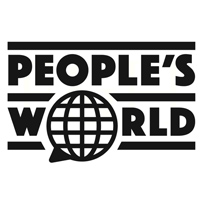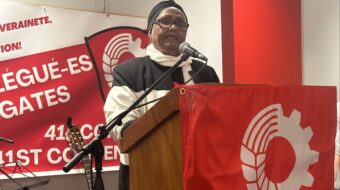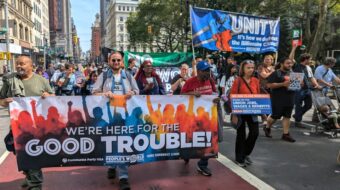The following is a Los Angeles Times article by reporter Hector Tobar.
LOS ANGELES (LA Times) — The year Rosalío Muñoz got his Vietnam War draft notice was also a very good year for American cinema.
It was the summer of 1969 and he spent hours in darkened L.A. movie theaters. “I saw ‘Easy Rider,’ ‘Alice’s Restaurant,’ ” he told me. “I’d sit in those theaters and do a lot of thinking.”
Movies featuring outlaws were then the vogue – ” Butch Cassidy and the Sundance Kid” was the big hit of the year. Muñoz eventually decided to resist the draft. He joined a movement whose climax was the Chicano Moratorium, an East L.A. antiwar march and civil rights rally on Aug. 29, 1970.
That day was, at once, one of the most hopeful and tragic in the history of Los Angeles. Three people were killed, including Times columnist Ruben Salazar, who was struck by a tear gas canister fired by a sheriff’s deputy. But a powerful spirit took root in the city.
“After that, we felt we owned the streets,” Muñoz said. “We got our voice.” The idea that L.A.’s Latino barrios could remain a world separate and unequal from the rest of the city was dead forever.
I spoke to Muñoz last week in a basement gallery downtown. All around him were photographs commemorating the moratorium’s 40th anniversary.
There are young men with raised fists who called themselves the Brown Berets. And a group of marching women known as Las Adelitas de Aztlan. A stylized portrait of Muñoz adorns a 1970 poster.
Today young people learn the story of Muñoz and his generation of L.A activists almost exclusively in classes devoted to Mexican American history. It bothers me that this is so.
If you look closely into that episode of L.A.’s past, you’ll see it’s impossible to separate Chicano history from white history or black history. It’s all our history.
“We’re part of the democratic traditions of this country,” Muñoz told me, referring to himself and the 30,000 others who rallied that day at an East L.A. park.
By his own account, the young Rosalío was not a likely candidate to become part of a Chicano Studies syllabus.
Now 64, he grew up in Highland Park when it was mostly white. His mother was a sixth-generation Mexican American and his father had a PhD. His friends were Italians and Anglos. He was known as Ross.
“It was ‘Happy Days,’ ” Muñoz said, referring to the TV sitcom set in the 1950s. Doug Smith, his friend and a future Times’ reporter, nominated Ross to be student body president at Franklin High. Ross won.
Later, in college, Muñoz studied European history. He didn’t know much about the Chicano movement.
“Muñoz, look in the mirror,” a Chicano activist finally told him. “You’re an Indian. And you will be part of our movement.”
After he was elected student body president at UCLA, he signed a pledge, along with hundreds of other student body presidents across the U.S., to resist the draft.
“For anyone who didn’t grow up in that era, it’s just about impossible to understand the enormous pressure the Vietnam War put on young people,” said Smith. Everyone knew someone who had been killed in Vietnam.
Activists told Muñoz that his minor celebrity as a student leader would help the antiwar movement gain support among Latinos – “sort of like Muhammad Ali,” he said.
Seeking inspiration, he attended a speech by the draft resister David Harris, but concluded his call for passive resistance “wasn’t going fly in the barrio.”
It what seemed like a cosmic coincidence, Muñoz was scheduled to report to the downtown L.A. induction center on Mexican Independence Day. So he wrote a speech about how Mexican Americans were dying in disproportionate numbers in Vietnam.
“I accuse the draft, the entire social, political, and economic system of the United States of America of creating a funnel which shoots Mexican youth into Vietnam to be killed,” Munoz wrote.
His literary inspiration was Emile Zola’s “J’Accuse.” And Smith gave him some writing tips.
National antiwar leaders were then organizing a moratorium, hoping to bring mainstream America out on the streets against the war.
The Chicano Moratorium had similar goals – to bring the ordinary people of L.A.’s barrios into the maelstrom then sweeping through the U.S. to protest the war in Vietnam and fight for civil rights.
They succeeded. The people marching that day weren’t just student radicals but also families with children and future intellectuals and elected leaders who would later join the mainstream of L.A. civic life.
Sheriff’s deputies swept through the park just as Muñoz took the podium, transforming the rally into panicked flight. But Muñoz would prefer you not focus on the day’s violent end.
“To me, the most important thing was how unified we were,” he said.
L.A. is today a more united place, I think, thanks to Chicano Moratorium. That might seem like an odd thing to say about a demonstration with a strong Brown Pride message. But the movement it started eventually brought dramatic changes to many of our public institutions, from the LAPD to the Board of Education. Its legacy is a more open, democratic city.
“Some people say that was the high point of the movement,” Muñoz said of Aug. 29. “But it was really only the beginning.”
If you have some time this summer, wander down to the basement of the Mexican Cultural Institute next to Olvera Street, and soak up a bit of our local history. The pictures will be up until July 25*.
For a sample of People’s World articles by Rosalio Munoz on the moratorium and other related topics, click here.
[Editors’ note: Due to a current glitch in the software, Munoz’s byline does not appear. This glitch affects a number of authors and is currently being worked on.]
Photo: Rosalio Munoz, in foreground. (People’s World)










